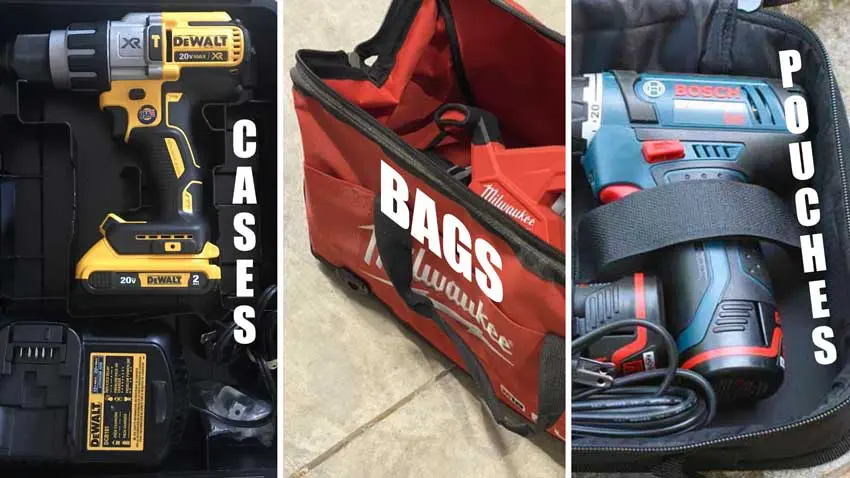Power tool packaging typically comes in either a case, a bag, or a zippered pouch. For some tools, one type of packaging may be better than another. We analyze the three most common styles that tools ship with. We also break down what we like and dislike (hate?) about each.
The Worst Power Tool Packaging: Rectangular Zippered Bags
We’ve complained in the past about these zippered cases. They seem to accompany 12V tools from companies including Bosch, Craftsman, and others. In reality, they defy logic.
These cases seem designed for people who may not actually use their tools all that often. You need to contend with the hassle of elastic straps and/or Velcro just to secure or release your tools. As for us, we find that these cases get tossed in the trash once we remove the tools. They offer very little protection and it takes too long to replace the tool—let alone the battery or charger.
In short, we wish manufacturers would stop using these rectangular zippered cases. As we mentioned, we throw ours out, opting instead to buy a standard tool bag with a single zippered top. Here are the pros and cons tabulated based on the combined experiences of those in our shop:
Pros
- Each component is held securely
Cons
- Not stackable (safely)
- Cannot (typically) store tools with bits
- No accessory storage
- Slow and cumbersome to use
- Offers little protection
Blow Molded Cases
Plastic blow molded cases are by far the most common case provided with new tools today. This especially holds true in the realm of specialty or high-end cordless power tools.

Manufacturers design these cases as custom-molded solutions for fitting the tool, battery, and charger securely. Often, they even leave room for some accessories such as blades or drill/driver bits. The downside to this type of case is the tendency for certain manufacturers to make them a bit too exact. They often forget to leave room for accessories and they sometimes make it difficult to wrap and store power cables for the battery chargers.
When a manufacturer designs a solid blow mold case, however, it really keeps your tools protected. It also gives you a way to stack and transport your tools without fear. Many manufacturers now include sticker labels on the sides of these boxes so you can quickly and easily identify the tools from the outside.
Here are our pros and cons for this type of tool package:
Pros
- Excellent tool protection
- Custom fit for easy storage of your tools
- Stackable & easily transported
Cons
- Potentially restrictive in space
- Can add unnecessary bulk & weight
Zippered Top Tool Bags
Tool bags with a zippered top resemble old-style doctors’ bags. We find these popular bags included with many tool brands’ products. Less expensive than blow molded cases, they can also ship with multiple tool lines without customization.
These bags typically hold up well. They also do offer some protection based on their inherent design, which is triangular. They have a tendency to naturally deflect objects away from the contents. Of course, drop something heavy on top and you’re on your own!
Since these bags lack many limitations other than volume, they offer ample storage for accessories. While they may not include enough space for storing a reciprocating saw along with its blade, most drills, circular saws, and other tools have tons of room.
We like these second only to a well-made blow-mold case. We frequently toss our zippered bags actually into the work van or truck. They also work really well for carrying combo kits and, in fact, many manufacturers ship their combo kits in bags like this (if they supply any storage at all). The pros and cons of this type of case seem obvious:
Pros
- Ample room for accessories and cord storage
- Typically robust with heavy-duty zippers and ballistic nylon
- Very portable and lightweight
Cons
- Only minimal tool protection
- May restrict storing tools with blades or bits
What About Premium Options?
Clearly, some manufacturers offer premium tool storage options for their products. You have some tools shipping in Milwaukee Packout boxes. Those offer stackability and integration with the entire Milwaukee Packout Modular Storage System.
The DeWalt ToughSystem 2.0 boxes have yet to integrate any power tools on a retail level as far as we’re aware. That would, however, be something worth checking out if they did.
Bosch L-Boxx storage provides stackability with most of the advantages of a traditional blow-molded case.
The TANOS Systainer Storage System includes various boxes that show up across many different manufacturers. This includes Festool and others.
Final Thoughts on Power Tool Packaging
So which type of power tool packaging do you like best? We have our preferences, but even the worst packaging won’t keep us from buying a power tool (especially if it’s on sale!) If anything, we hope this article shows you the trends so you can make your preferences more vocal.
Perhaps with enough consumer feedback manufacturers start listening and make more of the tool storage options we love. In fact, that already seems to be the case.
In general, we want more storage options that let you keep accessories with the tool. We want some basic tool protection, and we want enough room to not have to remove a bit or blade from the tool in order to fit it into the bag or case.
Current Power Tool Packaging Trends
Square zippered cases are, thankfully, rare. Some cordless products from Bosch (12V), Milwaukee (M12), and RIDGID (18V) still come in these cases. Other Milwaukee M12 tools come in a blow mold case. Milwaukee M18 tools mostly ship in large zippered tool cases or blow-molded cases. DeWalt ships most of their tools in custom blow-molded cases or zippered bags.
Here is a cool (non-exhaustive) breakdown of who (typically) ships using what type of storage:
- Zippered Top Tool Bags: Almost everyone, including Milwaukee, Ridgid, Ryobi, Metabo HPT, Makita, Kobalt, Flex, and others
- Blow Mold Cases: Just about every manufacturer ships their corded tools in a blow mold case or none at all. For cordless tools, higher end products show up in these from Milwaukee, DeWalt, Bosch, Makita, Bosch (18V), and others. Most pneumatic finish and roofing nailers also arrive in blow mold cases.
- Rectangular Flat Zippered Bags: Bosch 12V, Ridgid 18V, some Milwaukee M12
Power Tool Packaging Conclusion
One thing to keep in mind with power tool packaging is that they can come in the form of cases, bags, and pouches. For some tools, one type of packaging may be better than another, but you can always purchase a zippered tool bag later. We do this any time we get one of those square zippered cases.
Zippered bags also work great when you buy a bare tool or get no case or bag at all with your purchase. We also use them to break up combo kits. Some professionals like bags over blow-molded cases because they offer some friction. These do better when placed on shelves in a work van vs their plastic counterparts.
Finally, in the end, we can’t state it clearly enough—it’s the tool that you should shop for, not the case!
Code Embed: Cannot use CODE1 as a global code as it is being used to store 1904 unique pieces of code in 3321 posts





